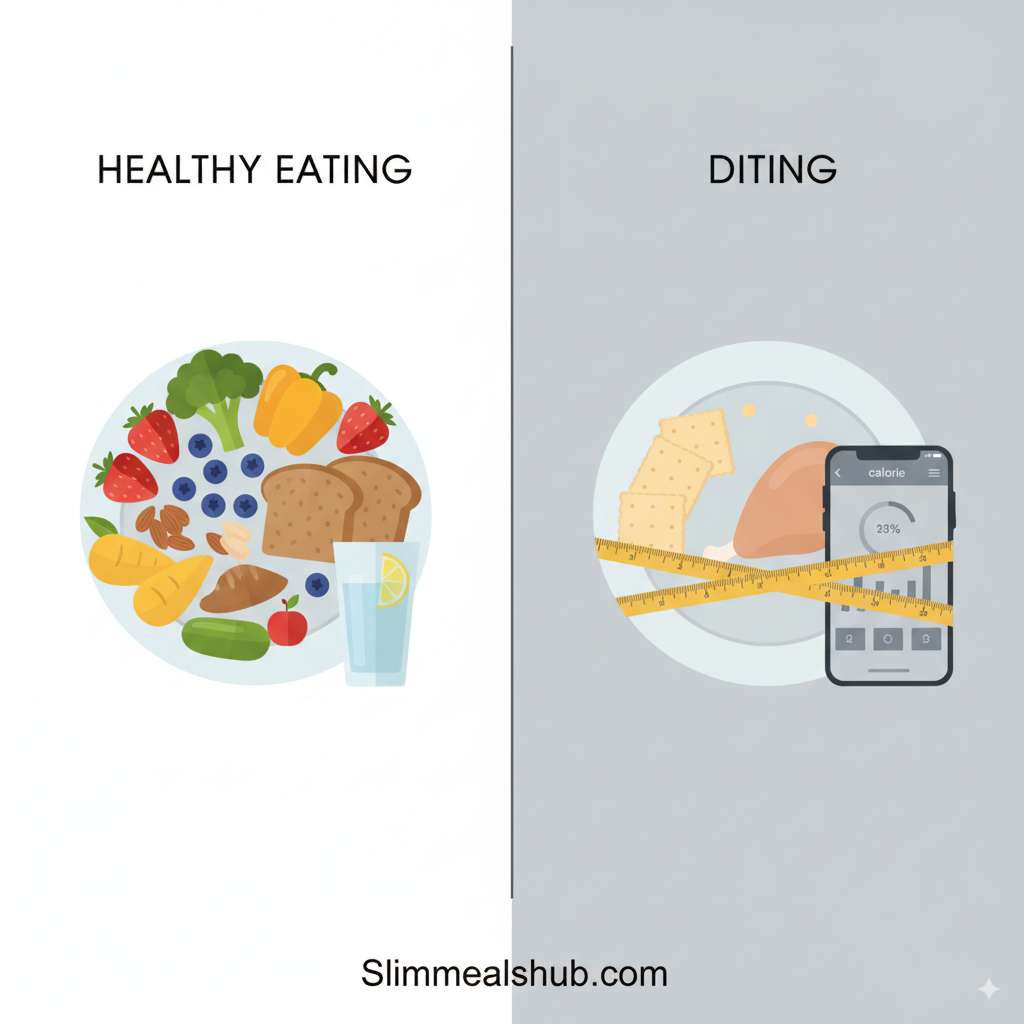In today’s health-conscious world, it’s easy to confuse healthy eating with dieting. Both concepts are often linked to weight management, fitness, and overall wellness. However, while they may overlap in certain areas, they are not the same thing. Understanding the difference between healthy eating and dieting is crucial if you want to build a sustainable relationship with food. This article explores the key distinctions, benefits, and drawbacks of each approach and provides tips on how to choose a lifestyle that works best for you.
Table of Contents
What is Healthy Eating?
Healthy eating is a long-term, balanced approach to nourishing the body with foods that provide essential nutrients for optimal functioning. Instead of focusing on restriction, healthy eating emphasizes variety, moderation, and quality. It’s about fueling your body with wholesome foods while still allowing room for enjoyment.
Key aspects of healthy eating include:
- Balance: Incorporating foods from all food groups (fruits, vegetables, proteins, grains, and healthy fats).
- Moderation: Avoiding overindulgence while still allowing occasional treats.
- Quality: Prioritizing nutrient-dense foods such as whole grains, lean proteins, fruits, vegetables, legumes, nuts, and seeds.
- Flexibility: Adapting to individual needs, cultures, and preferences.
Healthy eating focuses on long-term well-being, supporting everything from energy levels to immune function, and is not tied to quick fixes.
What is Dieting?
Dieting, on the other hand, generally refers to following a structured eating plan with specific rules or restrictions, often aimed at weight loss or managing a health condition. Diets are usually temporary and often emphasize control, calorie restriction, or elimination of certain food groups.

Common features of dieting include:
- Rules and restrictions: Specific guidelines on what, when, and how much to eat.
- Short-term focus: Diets are often followed for weeks or months, not for life.
- Weight-oriented: The main goal is usually weight loss or body composition changes.
- Types of diets: Popular examples include keto, paleo, intermittent fasting, vegan, or low-carb diets.
While dieting can sometimes yield results, it often comes with risks such as nutrient deficiencies, food obsession, and unsustainable habits.
Key Differences Between Healthy Eating and Dieting
- Mindset:
- Healthy eating is about long-term nourishment and balance.
- Dieting is usually about short-term control and restriction.
- Flexibility:
- Healthy eating allows freedom and adaptability.
- Dieting often imposes strict rules and limited options.
- Sustainability:
- Healthy eating can be maintained for life.
- Dieting is often temporary and hard to sustain.
- Goals:
- Healthy eating supports overall health, energy, and longevity.
- Dieting typically targets weight loss or quick results.
- Relationship with Food:
- Healthy eating encourages a positive, mindful connection with food.
- Dieting can lead to guilt, stress, or negative emotions toward eating.
Benefits of Healthy Eating
- Promotes long-term weight management naturally.
- Reduces the risk of chronic diseases like diabetes, heart disease, and cancer.
- Boosts energy, mood, and mental clarity.
- Provides flexibility for social events and cultural foods.
- Supports overall well-being rather than just body size.
Benefits of Dieting
- May provide quick weight loss or jumpstart healthier habits.
- Can be useful for medical purposes (e.g., low-sodium diets for hypertension).
- Structured plans can help beginners who need guidance.
- Some diets (e.g., plant-based) can align with ethical or environmental values.
Drawbacks of Healthy Eating
- Can feel vague without clear rules.
- Requires self-awareness and discipline to avoid overeating.
- May take longer to see weight loss results compared to restrictive diets.
Drawbacks of Dieting
- Often unsustainable long term.
- Can lead to yo-yo dieting or weight cycling.
- May trigger disordered eating habits.
- Restricts food enjoyment and social flexibility.
Healthy Eating in Practice
Healthy eating is not about perfection. Instead, it’s about making consistent, positive choices most of the time. Examples include:
- Filling half your plate with vegetables and fruits.
- Choosing whole grains over refined carbs.
- Opting for lean protein sources like chicken, fish, beans, or tofu.
- Incorporating healthy fats from avocados, nuts, and olive oil.
- Drinking water instead of sugary beverages.
- Practicing mindful eating to recognize hunger and fullness cues.
Dieting in Practice
Dieting usually involves specific plans that may include:
- Cutting calories to create a deficit for weight loss.
- Eliminating or reducing certain foods (like carbs in keto).
- Following time-based rules (like intermittent fasting).
- Using portion-controlled meal replacements.
While these approaches can be effective in the short term, their rigid nature makes them difficult to maintain.
Why People Confuse the Two
Healthy eating and dieting overlap because both involve making conscious food choices. For example, someone eating more vegetables and fewer processed foods may be dieting or simply eating healthier. The confusion arises because diet culture promotes restrictive approaches as the only way to be “healthy,” when in reality, sustainable health comes from balance.
Finding the Right Approach
The best approach depends on your goals, lifestyle, and mindset. Here’s how to decide:
- If you want long-term health and balance → focus on healthy eating.
- If you need structure for a short-term medical or weight-loss goal → a diet plan might help temporarily.
- If dieting feels restrictive or stressful → shift toward healthy eating to build a positive relationship with food.
Transitioning from Dieting to Healthy Eating
Many people start with diets but eventually move toward a balanced lifestyle. Tips for transitioning include:
- Shift focus from calories to nutrients.
- Practice portion control without rigid rules.
- Allow all foods in moderation.
- Replace “cheat days” with mindful flexibility.
- Create sustainable routines that fit your daily life.

